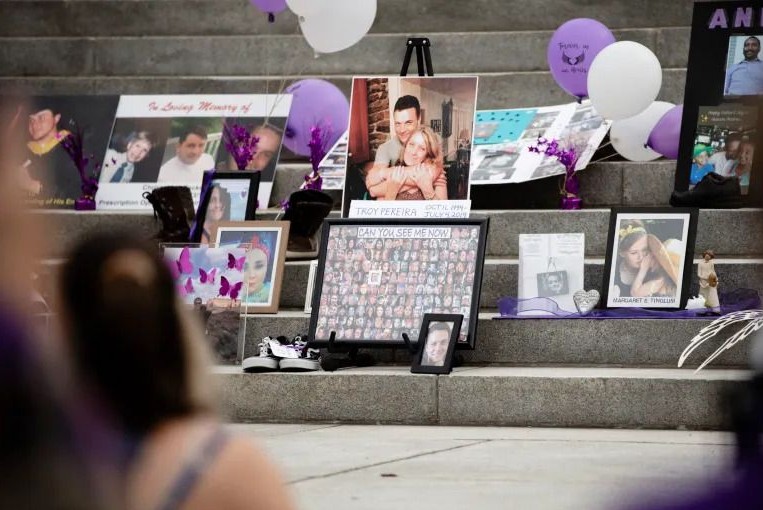

A memorial for those lost to opioid addiction reminds us of the need to demand that the voices of addiction survivors and loved ones of the lost be heard.
The opioid crisis of the 21st-century was caused by pharmaceutical manufacturers lying about the addiction potential of its products. The most impactful and most well-known lying corporation was Purdue Pharma, which argued that OxyContin, created using their patented, extended-release morphine sulfate, had a less than 1% chance of addiction.


A memorial for those lost to opioid addiction reminds us of the need to demand that the voices of addiction survivors and loved ones of the lost be heard.
Company officials claimed that only addicts’ destruction of the extended release technology, allowing the medication to become instant release, would cause the abuse of the drug. They said that people who didn’t do that, who nonetheless appeared to be addicted to OxyContin, were so because they were suffering from “pseudoaddiction,” which according to Purdue’s experts is the result of breakthrough pain and not actual addiction to the drug.
Purdue Pharma, the largest of the opioid creators and distributors to be involved in the opioid crisis, is still battling legal settlements. Its money has yet to be released to states, but this will most likely happen once they’ve exhausted their legal options. At that point, decisions will have to be made as to what to do with the money.
In the meantime, other drug manufacturers and distributors have been forced to pay for their role in creating the opioid epidemic. Teva Pharmaceuticals and pharmacies like Walgreens and CVS ended their legal challenges, and the Commonwealth of Pennsylvania received $2.2 billion as a result.
Settlement money funding prisons
While the idea that addiction being a disease is controversial, what is not controversial is that people who got roped into using these drugs didn’t make a choice in becoming dependent. That choice was made for them by people who cared only about their personal or industrial profits.
The corporations, through special prizes and rewards for both their sales teams and the doctors they worked with, essentially guaranteed that there would be addicted or dependent people, even if they abided by the original instructions (such as not crushing or scratching the pills.) Yet prosecutors are being given funds to fuel incarceration or forced treatment of drug users and drug addicts, while the corporate drug peddlers walk free.
An average street-level drug dealer has a higher chance of seeing the inside of a cell than any pharmaceutical company executive or sales agent ever will.
What has Pennsylvania done with the money it received so far from the opioid settlements? It has used it to punish drug addicts for using the opioids that the corporations essentially set up to fail.
Aspects of the “criminal justice system” are being funded with opioid settlement money. Prisons and county jails were given new scanners, with the logic that because some drug users and drug addicts are incarcerated, this will help “connect people to treatment.” It won’t.
What would, however, help connect people to treatment is to put more money into the public defender system. While it is flawed, like all aspects of the “criminal justice system,” public defenders are the ones capable of linking people to treatment and making plea deals to encourage users to get help instead of struggling alone in a prison or jail cell.
Philadelphia’s newly elected Mayor Cherelle Parker proposed the tried and failed methodology of the “War on Drugs”: Force addicts into treatment or send them to jail. Pretending that every single addict in Kensington wanted to get help, there still would not be enough Medicaid or public assistance-funded beds in Philadelphia and its surrounding counties.
There is a crisis in Pennsylvania and throughout the United States — a lack of adequate, safe recovery beds. Whether it’s a lack of dual diagnosis beds for people who struggle with addiction or drug misuse and mental illness or a lack of beds just for non-mentally ill users, there are not enough for everyone who wants, let alone needs, one.
Crisis in lack of recovery options
The money from the Opioid Settlement Fund needs to be used in a different way than it currently is. While state spending is highly complex, it should be obvious that using money intended to help people just to punish them is not the way to go.
The state government, as the keeper of the OSF money, ought to be asking drug users and addicts in recovery, as well as the loved ones of drug users who have died, how they believe the money should be used. There is an immense need for the treatment system to be improved and reinforced, and this money could help with that.
It should be noted, however, that most of Pennsylvania’s opioid settlement money is being allocated on a county basis. Only a small amount of the money is used by the state for state programs. This is a good starting point in viewing the problem, because each county is impacted differently by the opioid epidemic. But to let counties use it to fund the injustice system is unconscionable.
The counties should use the money to fund stays in recovery houses, such as halfway houses or sober living homes, for people who cannot afford to get into them. A major point of failure for rehabilitation patients getting out of treatment is that they cannot afford the housing needed to help them establish new, drug-free lifestyles.
Direct funds to families!
What could Pennsylvania do with its portion of the money, other than spending it on the state prison system?
The money should be allocated toward restoring or helping the families of loved ones who struggle with problematic substance use. Many families plunge themselves into debt to get their loved ones into treatment.
Sometimes, this treatment works and the families get their loved ones back. Oftentimes, people die due to inadequate treatment methodologies or the revolving door method of scamming people by the recovery industry owners.
Whether the money is distributed to get the families out of debt or distributed to help them pay for funeral or cremation costs, they deserve to get the help they need from wicked pharmaceutical companies. These profiteers murdered their loved ones. For any other unnatural death, crime victims and their families are sometimes compensated. Why shouldn’t this be the case for deaths from opioid use?
A dear friend, Susan, lost her son, Tyler, to problematic substance use. She founded the Vilomah Foundation to aid the families of those whose loved ones had died or were dying. As part of her activism, she has demanded that some of the money given to the states be used to memorialize the lost. No parent should ever have to bury their child, and they certainly should not have to deal with knowing that criminals like the Sackler family, which profited from Purdue Pharma, will almost certainly not be treated like the drug traffickers they are.
There are other national uses for the money that need consideration. Expansion of research projects for new medications for opioid use disorder would, for instance, be useful on the national stage. Research into Canada’s methods of treating this disorder would be helpful.
A revolution in drug treatment and approaches to the opioid epidemic are needed, but in the meantime even reform could save lives or help to bring peace to people. Nothing pharmaceutical companies can do will help people who have lost loved ones, but their punitive fines and payments could keep others from dying. We have to push. We owe it to the lost.
Boston Baristas at Blue Bottle coffee shops in Boston are so fed up with their…
En su continua campaña genocida contra el pueblo palestino, Israel utilizó aviones no tripulados el…
Israeli military veteran in Warsaw: ‘Liberate all ghettos’ By Michael Kramer On the 82nd anniversary…
The Vietnamese revolution to liberate its country from imperialism had a decisive victory 50 years…
The epic struggle of the Palestinian people against the full weight of U.S. imperialism and…
The following report comes from the Bronx Anti-War Coalition organizers on a protest held in…